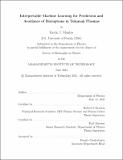Interpretable Machine Learning for Prediction and Avoidance of Disruptions in Tokamak Plasmas
Author(s)
Montes, Kevin J.
DownloadThesis PDF (3.777Mb)
Advisor
Granetz, Robert S.
Marmar, Earl
Terms of use
Metadata
Show full item recordAbstract
Tokamak plasmas are sometimes terminated due to off-normal events called disruptions, which are characterized by successive thermal and current quench events that deplete the stored thermal and magnetic energy. In addition to the costs of disruptions due to loss of confinement and operation, their corresponding thermal, electromagnetic,
and potential runaway electron loads can cause significant structural damage to the tokamak’s plasma facing components. Therefore, disruption forecasting algorithms are needed to either avoid disruptions altogether via plasma control, or to mitigate their deleterious effects once they happen. A limited physical understanding and wealth of experimental tokamak data from decades of research make this problem ripe for machine learning-based prediction and control, yet it is often difficult to explain how these data-driven algorithms make particular predictions. This thesis demonstrates the novel application of data-driven methods to address this issue via two main contributions. For the first, databases of thousands of discharges on multiple
tokamaks were used to develop a random forest disruption predictor, demonstrating a relatively low limit for feasible disruption prediction on Alcator C-Mod when compared to DIII-D and EAST. Its predictions are shown to be interpretable using metrics known as feature contributions, which were made available in real-time experiments on the DIII-D tokamak to inform control actions. For the second contribution, the semi-supervised label spreading algorithm is applied to detect events
often preceding disruptions in a large set of discharges, given few manually labeled examples. A method is proposed to construct event databases from scratch with the algorithm, and an accompanying software module was developed and made available for this purpose.
Date issued
2021-06Department
Massachusetts Institute of Technology. Department of PhysicsPublisher
Massachusetts Institute of Technology